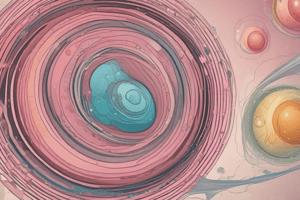Podcast
Questions and Answers
What is the purpose of the acrosome releasing enzymes during fertilization?
What is the purpose of the acrosome releasing enzymes during fertilization?
- To reach the fallopian tube
- To protect the sperm cell
- To create a fusion pore
- To digest the zona pellucida (correct)
What is the name of the temporary bridge created when the sperm cell's head fuses with the egg cell's plasma membrane?
What is the name of the temporary bridge created when the sperm cell's head fuses with the egg cell's plasma membrane?
- Zygote
- Fusion pore (correct)
- Embryo
- Acrosome
Where does the fertilization process typically occur?
Where does the fertilization process typically occur?
- Uterus
- Fallopian tube (correct)
- Cervix
- Ovary
What happens if fertilization does not occur within the first few days?
What happens if fertilization does not occur within the first few days?
What facilitates nutrient and waste exchange between the mother and developing baby?
What facilitates nutrient and waste exchange between the mother and developing baby?
What does the zygote develop into after successful fertilization?
What does the zygote develop into after successful fertilization?
What is the core process in human reproduction?
What is the core process in human reproduction?
What is the function of the acrosome in a sperm cell during fertilization?
What is the function of the acrosome in a sperm cell during fertilization?
When does ovulation typically occur in a 28-day cycle?
When does ovulation typically occur in a 28-day cycle?
What is the role of the corona radiata and zona pellucida in an egg cell?
What is the role of the corona radiata and zona pellucida in an egg cell?
Where does capacitation of sperm cells occur?
Where does capacitation of sperm cells occur?
What happens when a sperm cell encounters an egg cell during fertilization?
What happens when a sperm cell encounters an egg cell during fertilization?
Study Notes
Unraveling Human Reproduction: Fertilization
Human reproduction is a remarkable process that results in the creation of new life. At the core of this process lies fertilization, the moment when a sperm cell unites with an egg cell, or ovum, to form a single cell, known as a zygote. This zygote goes on to develop into a human being, beginning its journey from the smallest of beginnings, just a few micrometers in size.
The Male Role in Fertilization
A healthy adult human male can produce up to 1,500 sperm cells per milliliter of semen. These sperm cells are equipped with a tail (flagellum) that propels them through the female reproductive tract. Upon entering the fallopian tube, some sperm cells will undergo a process called capacitation, which makes them more capable of fertilizing the egg. The sperm cell's head contains a unique molecule called the acrosome, which contains enzymes that will be released to help it penetrate the egg's outer layer.
The Female Role in Fertilization
A healthy adult human female produces about one egg cell (ovum) each month during ovulation, which typically occurs around mid-cycle (day 14 in a 28-day cycle). The ovum is surrounded by a protective layer called the corona radiata and the zona pellucida, a glycoprotein-rich layer that covers and shields the ovum as it is propelled through the fallopian tube.
The Meeting of the Parents
When a sperm cell encounters an egg cell, it must first bind to the zona pellucida before penetrating it. The sperm cell's tail continues to propel it forward, and it eventually deploys its acrosome, releasing enzymes that digest the zona pellucida, allowing the sperm cell to reach the egg's surface. The sperm cell's head then fuses directly with the egg cell's plasma membrane, creating a temporary bridge called the fusion pore. This fusion pore allows the transfer of genetic material between the sperm cell and the egg cell in a process called the sperm-egg fusion.
Fertilization Success and Timing
The success of fertilization depends on various factors, such as the sperm cell's ability to penetrate the zona pellucida and fuse with the egg cell, as well as the egg cell's ability to accept the sperm cell. The fertilization process typically occurs within the fallopian tube, but if it doesn't happen in the first few days, the egg cell will disintegrate.
Post-Fertilization Changes
After successful fertilization, the zygote continues to divide and develop, eventually forming an embryo. The embryo then enters the uterus, where it implants itself into the uterine lining, creating a placenta that facilitates nutrient and waste exchange between the mother and the developing baby. Over the next nine months, the embryo grows into a fetus, and the baby is born, ready to begin its own incredible journey of life, all starting with the union of sperm and egg in the process of fertilization.
Studying That Suits You
Use AI to generate personalized quizzes and flashcards to suit your learning preferences.
Description
Explore the intricate process of human fertilization, where a sperm cell unites with an egg cell to form a zygote, initiating the development of new life. Learn about the roles of male and female reproductive cells, the fusion process, factors affecting fertilization success, and post-fertilization changes leading to embryo and fetus formation.




